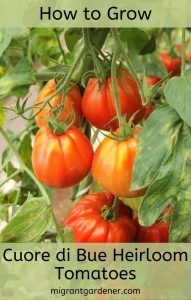How to Grow Cuore Di Bue Tomato
‘Cuore di Bue’ which literally translates from Italian to English as ‘oxheart’ is named because of its oxheart shape. The Cuore di Bue tomato is an heirloom tomato variety and hails from northern Italy.
The fruit is dense and carries few seeds. It cooks nicely to make a lovely thick sauce, or it can be beautiful when roasted. In fact, ‘Cuore di Bue’ is very meaty and heavy and it is plenty rich in terms of flavor.
Further, ‘Cuore di Bue’ is a great slicer and is ideal when paired with fresh basil and mozzarella or together with a fresh salad. Some say that ‘Cuore di Bue’ makes the very best tomato-based sandwiches to be found anywhere!
Mind you, taste is a very personal thing…
How to Grow ‘Cuore di Bue’ Tomato Plants – Growing Facts
Native to the Andes, the indeterminate ‘Cuore di Bue’s’ tomatoes ripen around the 75- to 85-day mark from transplanting.
The vines grow upwards of 6 feet (2 meters) in height.
The fruits, which are orange-red in color, have a relatively unique oxheart shape. The fruits weigh between 6 to 12 ounces (170-340 g) though sometimes they – a single ‘Bue di Cuore’ tomato – will grow to 1 pound (454 g) in weight.
Don’t be disheartened if your tomato plants start out the growing cycle in a pretty feeble way. The foliage is wispy and weak. This tends to be normal. In comparison to other varieties, ‘Cuore di Bue’ tends to look weak even up to the point of transplanting to the garden if you do indeed transplant to the garden.
Give them around a month or so after transplanting and you’ll likely find your plants suddenly explode into growth – finally! Actually, you may find them to be more vigorous than any of your other tomato plants, which is rather strange, given they are so slow to get going.
‘Cuore di Bue’ are pretty late in producing fruit. Again, nothing to worry about. Patience is a real virtue with this tomato plant.
Anyway, to begin, sow your ‘Cuore di Bue’ tomato plants in spring at around 1/16 inch (1.6 mm) deep. Germination will typically take approximately 6-14 days if temperatures are optimal – between 65-75 degrees F (18-24 centigrade).
When they are plenty large enough to handle, transplant your seedlings to 3-inch (7.6 cm) pots.
Grow the seedlings in slightly cooler conditions until they reach around 8 inches (20 cm) in height then plant them inside your greenhouse. Either that or you can plant outside but they do need to be acclimatized first to handle outdoor temperatures.
Plant the seedlings approximately 18 inches (45 cm) apart and if you are locating them outdoors make sure they are positioned in a sunny, warm spot.
Ideally, the soil should be well-drained but still capable of retaining moisture. Add some organic matter (compost, moss, peat from a renewable source) and keep your tomatoes well watered, particularly during times when temperatures are on the rise.
‘Cuore di Bue’ tomato plants grow to a height of around 6-7 feet. Still, even though that’s not particularly vigorous, they will need staking or caging.
I like to invest in stakes that are plenty long enough to cover the entire growing season. I mean, why buy 4-foot stakes if your tomatoes are going to grow 8-9 feet in height? Makes little to no sense.
6ft-Tall Natural Bamboo Stakes for Tomatoes
I really like these Velcro ties as well. They don’t do any damage to the plants.
What Fertiliser is Best for ‘Cuore Di Bue’ Heirloom Tomatoes?
Each week to two weeks, give your tomato plants some fertilizer.
To start out, a fertilizer that is high in nitrogen is best. That’s because nitrogen is essential for foliage growth. And we want our tomato plants to produce healthy foliage from the get-go.
A fertilizer that I frequently use is Osmocote Smart Release. It has a macronutrient (NPK) ratio of 15-9-12. Additionally, it comes with nine other micronutrients.
Osmocote Smart-Release Plus Fertilizer (with 12 nutrients)
From mid-season onwards, your tomatoes will be getting ready to set fruit. In which case, the plants will greatly benefit from additional potassium (K) and less nitrogen (N).
Potassium is essential for healthy fruit growth. I like the Miracle-Gro Tomato Fertilizer with its 18-18-21 NPK ratio.






Looking at the picture they have the opposite shape of an oxheart tomato. These appear fat at the bottom, tapered more narrow toward the top. So the name isn’t exactly true to the shape. After some searching for ‘Cuore Di Bue’, depending on seed suppliers, you’ll find both shapes. I can only conclude the two are not the same tomato. I’ll be looking to try the one in the picture next summer.
Hi John, I suppose if you turned the tomato (shown in the image) upside down you’d have more of a ‘cuore di bue’ shape. Anyway, and more seriously, you could be and most likely are right – the two tomatoes that you’ve highlighted in your comment are not, in fact, the same tomato at all. Happens all too often these days when a seed supplier claims the seeds to be one thing when in reality, they are something rather different.